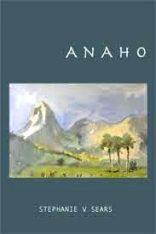Jun 23 2023
London Grip Poetry Review- Stephanie V Sears
Poetry review – ANAHO: Daniel Barbiero reviews a new collection of poems of place composed by Stephanie Sears
Anaho Stephanie V. Sears Arteidolia Press ISBN 978-1-7369983-9-7 104 pp $16
Stephanie V. Sears’ Anaho is a collection of poems written in or evoking places as varied as French Polynesia, the Himalayan mountains, and central Italy. Sears is a French-American writer, ethnologist, and photographer resident in Paris and, for her, movement is life, at least to the extent that it involves travel to places virtually anywhere on the planet, no matter how remote.
We get a sense of this right away. The first section of this three-part book is titled “Moana”, meaning lagoon. The poems here have their root in the South Pacific as indicated by a number of their titles: “Savai’i,” named for a Samoan island; “One Afternoon at Teahupo,” set in a coastal village on Tahiti; and the title poem itself, named for a bay on Nuka Hiva in the Marquesas Islands. Sears articulates the sensual immediacy of what it is like to be there in a set of images alluding to the ambient sights, sounds, and scents. Take, for example, this passage from “One Afternoon at Teahupo”:
I, honed by fragrance and flux Of vanilla and brine, am seen By the skyline’s fish eye. I free a catharsis of syllables To formulate tranquility Of the endless phrase In a monochrome of gold At this time Surfers rewound by a constant cameraman. Sun steam meets sun shower Cutting facets on weather’s gem. A pink balloon caught in a tree Turns itself into a barrel-man.
The poem is a sequence of impressions—visual, olfactory, tactile—conveyed through images that accumulate to give a vivid sense of what the speaker experiences or imagines while watching surfers in the bay. The setting may be distant and unknown to many readers, but Sears’ focus on what things look, smell, and feel like makes it something we can visualize as though we were there. By keeping her eye directed toward the living details of the scene she avoids reducing it all to a superficial exoticism and paradoxically makes the unfamiliar seem familiar.
Sears’ attunement to the visual as a sensual dimension soliciting our attention is particularly well-represented in Anaho. The book’s second section in fact is titled “Bokeh,” a Japanese word referring to the luminous aesthetic qualities of the out-of-focus background in a photograph. A concern with bokeh implies an indirect aesthetic concerned as much with the vague but pervasive effects of atmosphere as with the sharply defined figures explicitly taken to define what the photograph is about. From Anaho’s second section “Looking Through the Trees,” written about the effects of changing light on trees seen during a winter sunset, is a verbal analogue of this indirect visual aesthetic:
Winter transforms sunset into revelation, Slyly turns a key, releasing An exclamation into afternoon, Something from beyond my view. The illuminated trees brighten into seers With clever eyes that bore into What I cannot see. They have begun To stretch upward, All the while staying put. Drawing attention to the sky, Pulling it in Like a blue ship, Sailing it with their branches.
The trees are figures against a field, but the field makes itself felt through these figures ‘drawing attention to the sky’ in the background. By their brightness they imply the reciprocal darkening of the sky behind them. The revelation Sears refers to is as much an effect of the diminishing play of light in the background as it is of the trees’ contrasting illumination.
The concluding section of the book is titled “Phantoms,” and here the center of gravity of the poems shifts from the sensual phenomena of the external world to the internal world of memory and introspection. A stanza from “Pisani Palace” is representative:
Drop by drop, soundlessly fall elusive sprites of dusk. They bear standards of memory inscribed with question marks about aureate fantasies in which answers hide as in the heart’s depths.
Pisani Palace is an historic building on the Grand Canal of Venice, itself a city in which memory makes strong claims on a present reality of depopulation and the future prospect of gradual disappearance under water. In the poem, the palace serves as a kind of house of memory, its various rooms and corridors recalling past events running ‘from seduction to murder,/costumed in shrouds of history’ and in which ‘Each stalwart statue/proclaims the ascendancy of a ghost/and the inscrutable nature of a shadow.’
Although the poems in the final section of Anaho mark a turn inward, they still contain the kind of strong imagery that runs throughout the book. Whether addressing places on earth or in thought, Sears’ collection is consistent in its sharp perception of the things of the world, both as they are in their appearances as themselves and as emblems animated by imagination and reflection.
Daniel Barbiero is a writer, double bassist, and composer in the Washington DC area. His essays and reviews have appeared in Heavy Feather Review, periodicities, Word for/Word, Otoliths, Arteidolia, The Decadent Review, Perfect Sound Forever, Point of Departure, and elsewhere. He is also the author of As Within, So Without, a collection of essays (Arteidolia Press, 2021).

ARTEIDOLIA
05/10/2023 @ 14:09
[…] Read the full review on the London Grip ? […]
Anaho by Stephanie V Sears « ARTEIDOLIA
11/11/2023 @ 14:23
[…] Read the full review ? […]